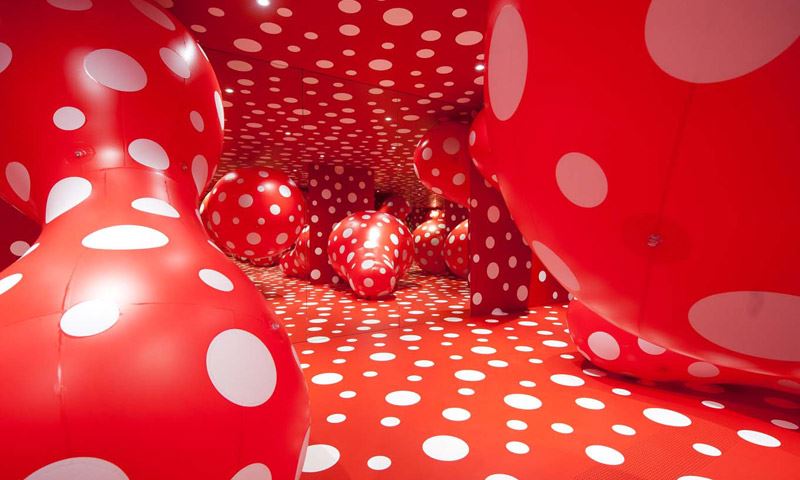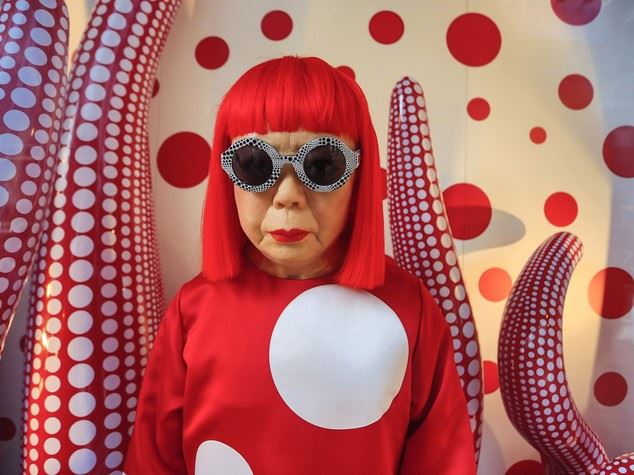19/07/2021
The queen of polka dots: Yayoi Kusama

by Giulia De Sanctis
Brilliant and chameleonic, the Japanese artist Yayoi Kusama is considered by most the queen of polka dots, famous dots with which she filled living rooms and streets of New York from 1958 to 1973 in an era of transition from abstract expressionism to avant-garde experimentalism. Installations, bodypainting performances and abstract paintings, what most distinguished her works was the courage with which she gave the body to her interior landscapes. Her works in fact fully express her psychological and emotional dilemmas that since childhood have tormented her. As a child, she began to have visual and auditory hallucinations and her way of reacting to them was to find support in art, turn it into an antidote and her source of inspiration in adulthood. She always devoted herself to the study of art and one day she approached Georgia O'Keeffe’s paintings, wife of Alfred Stieglitz. She decided to write to her and it was just after receiving her reply that Yayoi moved first to Seattle and then to New York and, after a hard time, she began to exhibit her first creations, consolidating her position in the New York avant-garde scene and becoming at all effects a revolutionary artist. Not to be forgotten is her participation, along with Louise Bourgeois and Eva Hesse, at the exhibition "Eccentric Abstraction" in New York, establishing herself among the avant-garde of feminist artists of the 60s. Her style consists of multiplying endlessly and obsessively bags filled with cotton and colored white that represents the phallus, thus creating fields of protrusions, between the minimalist object and the pop images, for her obsessive use of red polka dots. The phallus is thus transformed into a parody of itself and the environments, together with the objects, become indistinct, submerged by white polka dots and cocoons.

Her
most famous artworks include her
Infinity Mirror Rooms,
Accumulations (1961),
House of Infinite Mirrors - Field of Phallus (1965). Kusama returned to Japan in 1970 because of severe mental health issues that forced her to retire from the art scene for a few decades and to be forgotten by the America that had embraced her until a few years earlier. In
1993 she returned to her artistic production
representing Japan at the 45th Venice Biennale, while in
2017 she presented the
works "Yayoi Kusama: Infinity Mirrors" at the
Hirshorn Museum in
Washington D.C,
"Yayoi Kusama: Life is the Heart of Rainbow" at the
National Gallery in
Singapore and
two other
solo exhibitions at the
David Zwirner in
New York; she also participated,
in 2020 with a
solo exhibition, at the
Tate Museum’s 20 years anniversary in London.
 After graduating from language high school, love for art led Giulia De Sanctis (Turin, 1998) to obtain Communication and Enhancement of Artistic Heritage’ degree at the Accademia Albertina di Belle Arti in Turin. She collaborated with art galleries in Turin as an assistant, dealing with the cataloging of the works, the preparation of exhibitions and the press office. She collaborates actively with various magazines and web publications of the art sector.
After graduating from language high school, love for art led Giulia De Sanctis (Turin, 1998) to obtain Communication and Enhancement of Artistic Heritage’ degree at the Accademia Albertina di Belle Arti in Turin. She collaborated with art galleries in Turin as an assistant, dealing with the cataloging of the works, the preparation of exhibitions and the press office. She collaborates actively with various magazines and web publications of the art sector.




 This site uses anonymous technical cookies to ensure navigation and third-party cookies to monitor traffic and to offer additional services such as viewing videos or messaging systems. Without third-party cookies some pages may not work properly. Third-party cookies can track your activity and will only be installed by clicking on the "Accept all cookies" button. You can change your selection at any time by clicking on the "Cookie" link on each page at the bottom left. By clicking on one of the two buttons you declare that you have read the privacy policy and to accept the conditions.
This site uses anonymous technical cookies to ensure navigation and third-party cookies to monitor traffic and to offer additional services such as viewing videos or messaging systems. Without third-party cookies some pages may not work properly. Third-party cookies can track your activity and will only be installed by clicking on the "Accept all cookies" button. You can change your selection at any time by clicking on the "Cookie" link on each page at the bottom left. By clicking on one of the two buttons you declare that you have read the privacy policy and to accept the conditions.